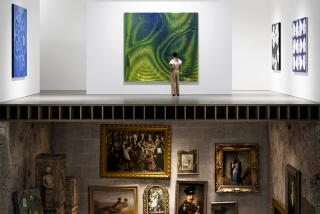A jewel box of Southern art
- Share via
NEW ORLEANS — For years, the South has been celebrated as a wellspring of American music and literature. But wide recognition of its visual arts has been restricted largely to crafts or the work of self-taught naive artists.
A fuller picture of the breadth of art from the region emerged this weekend with the opening here of the ambitious $21-million Ogden Museum of Southern Art and the unveiling of a diverse collection of contemporary and historical artworks that the museum touts as the largest of its kind in the world.
The museum, affiliated with the Smithsonian Institution and the University of New Orleans, is the new home for 2,750 Southern artworks, nearly half of them from the collection of Louisiana real estate developer and philanthropist Roger Ogden.
The Ogden has already become a magnet for donations of other regional artworks that might otherwise have been dispersed to collections outside the South.
“What makes the Ogden important is that it openly commits itself to being a museum for Southern art,” said Benny Andrews, a Brooklyn-based painter from Georgia whose work has been collected by the Museum of Modern Art. He has pledged to give 200 works to the Ogden.
“We have a fairly unique mission,” the museum’s curator, David Houston, said at one of the opening parties. “What we offer is a context for artists working in the South. This place will become a repository.”
To art collectors who have quietly driven up the prices of early 20th century Southern landscapes in the past two decades, many of the paintings at the Ogden will not come as a surprise. There are lush moonlit pastoral oils by Clarence Millet and dramatically colored Mississippi River scenes by Will Henry Stevens. There are Southern classics, like Christopher Clark’s 1936 “The Crapshooters” and Marie Atchinson Hill’s 1935 “Tenant Farmer.”
The photography collection has many characteristically haunting images of poor rural Southerners, burned-down plantations and abandoned sharecropper shacks -- including sepia images taken by celebrated Mississippi novelist Eudora Welty during the Depression, when she was a publicist for the Works Progress Administration.
But the opening exhibition, “The Story of the South: Art and Culture 1890-2003,” attempts to go beyond such familiar fare. Along with an entire gallery of self-taught artists, there is a contemporary satirical sendup of naive painting, “Trinity -- Elvis, Jesus and Robert E. Lee,” by Clyde Broadway. Modern landscapes such as “View From the Prairie,” a brilliantly colored meditation on the Louisiana rice-growing region by Elemore Morgan Jr., seem to reinvent the historical landscapes with highly graphic or abstract approaches.
“Arts critics have pigeonholed the South,” Morgan said. “A very strong aspect of Southern art, like its music and literature, is narrative. But a lot of it is abstract, and that does not fit the stereotype of Southern art.”
The Ogden collection is anything but stereotypical: Pop artist Robert Rauschenberg, a Texas native, is represented, as is Southern-born artist Jasper Johns. Also included is work that touches on Southern themes, including a Larry Rivers painting, “The Last Civil War Veteran,” that depicts a man asleep under a Confederate flag and uniform suspended in the air. Video monitors broadcast random Southern images: a waving beauty queen, a burning cross.
The exhibition is housed in a modern structure built for the museum’s 20th century art collection. Two wings are scheduled to open in 2004 to house the 18th and 19th century works.
As is often the case in the South, the opening was complicated by an uncomfortable legacy of the past. Sandwiched between the new structure and a preexisting one stands a red brick building that since 1891 has housed the Confederate Museum. Years ago, 60,000 Southerners once paid homage to the bones of Jefferson Davis here, but today guidebooks to New Orleans’ new downtown arts scene don’t mention the place.
The University of New Orleans Foundation, which bought the Ogden site, claims ownership of the Confederate Museum building. But the museum refused to budge. A few days before the Ogden opening, a compromise was hammered out allowing the Confederate Museum to stay, with a passageway connecting the Ogden buildings.
“The goal is to live side by side peacefully,” said David Voelker, vice chancellor of the University of New Orleans. “It will continue as it has been for 150 years.”
The staff of the Confederate Museum watched the Ogden ribbon-cutting ceremony from the windows Saturday morning.
“Art represents the very best of mankind,” Ogden told the crowd. “This is our gift to you.”
More to Read
The biggest entertainment stories
Get our big stories about Hollywood, film, television, music, arts, culture and more right in your inbox as soon as they publish.
You may occasionally receive promotional content from the Los Angeles Times.










